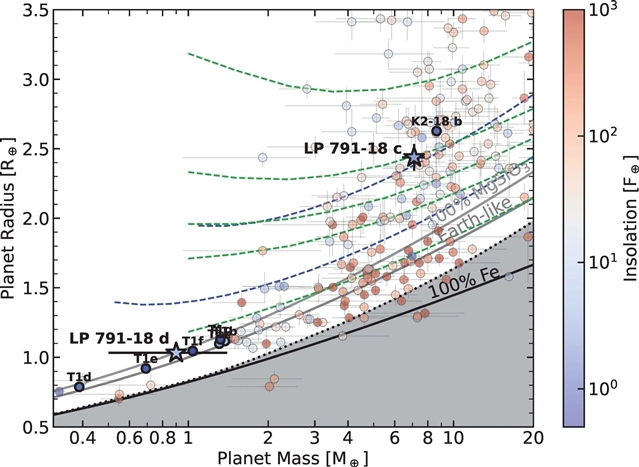
近日,加拿大蒙特利尔大学物理系和Trottier外行星研究所的Björn Benneke及其领导的研究小组取得一项新进展。经过不懈努力,他们成功发现了一颗绕M6矮星运动时发生潮汐加热的温和地球大小行星。相关研究成果已于2023年5月17日在国际权威学术期刊《自然》上发表。
该研究小组发现了绕冷的M6矮星LP 791-18运动的一颗温和地球大小行星。新发现的行星LP 791-18d的半径为1.03±0.04R⊕,平衡温度为300-400K,其永久黑夜面可能有利于水的凝结。LP 791-18d是一个共面系统的组成部分,为研究人员提供了一个迄今为止独特的机会,可以在一个保留了气体或挥发性物质包层的次海王星系统中研究一个温和的类地外行星。通过对凌日时间变化的观测,研究人员发现次海王星LP 791-18c的质量为7.1±0.7M⊕,而类地外行星LP 791-18d的质量为0.9+0.5-0.4M⊕。次海王星的引力相互作用阻止了LP 791-18d轨道的完全圆化,导致LP 791-18d的内部持续受到潮汐加热,表面可能存在强烈的火山活动。
据介绍,温和的late-M矮星周围的地球大小系外行星为他们提供了一个难得的机会,探索在哪些条件下行星可以发展出适宜的气候条件。较小的恒星半径增强了大气凌日特征,使得即使是以N2或CO2为主的紧密次级大气层也可以用现有仪器进行表征。然而,尽管进行了大规模的行星搜索努力,但在温和的late-M矮星周围发现低温地球大小的行星仍然很罕见,并且TRAPPIST-1系统,一个具有看似相同组成的岩石行星的共振链,尚未显示出系统中存在挥发性物质的任何证据。
附:英文原文
Title: A temperate Earth-sized planet with tidal heating transiting an M6 star
Author: Peterson, Merrin S., Benneke, Björn, Collins, Karen, Piaulet, Caroline, Crossfield, Ian J. M., Ali-Dib, Mohamad, Christiansen, Jessie L., Gagn, Jonathan, Faherty, Jackie, Kite, Edwin, Dressing, Courtney, Charbonneau, David, Murgas, Felipe, Cointepas, Marion, Almenara, Jose Manuel, Bonfils, Xavier, Kane, Stephen, Werner, Michael W., Gorjian, Varoujan, Roy, Pierre-Alexis, Shporer, Avi, Pozuelos, Francisco J., Socia, Quentin Jay, Cloutier, Ryan, Dietrich, Jeremy, Irwin, Jonathan, Weiss, Lauren, Waalkes, William, Berta-Thomson, Zach, Evans, Thomas, Apai, Daniel, Parviainen, Hannu, Pall, Enric, Narita, Norio, Howard, Andrew W., Dragomir, Diana, Barkaoui, Khalid, Gillon, Michal, Jehin, Emmanuel, Ducrot, Elsa, Benkhaldoun, Zouhair, Fukui, Akihiko, Mori, Mayuko, Nishiumi, Taku, Kawauchi, Kiyoe, Ricker, George, Latham, David W., Winn, Joshua N., Seager, Sara, Isaacson, Howard, Bixel, Alex, Gibbs, Aidan, Jenkins, Jon M., Smith, Jeffrey C., Chavez, Jose Perez, Rackham, Benjamin V., Henning, Thomas, Gabor, Paul, Chen, Wen-Ping, Espinoza, Nestor, Jensen, Eric L. N., Collins, Kevin I., Schwarz, Richard P., Conti, Dennis M., Wang, Gavin, Kielkopf, John F., Mao, Shude, Horne, Keith, Sefako, Ramotholo
Issue&Volume: 2023-05-17
Abstract: Temperate Earth-sized exoplanets around late-M dwarfs offer a rare opportunity to explore under which conditions planets can develop hospitable climate conditions. The small stellar radius amplifies the atmospheric transit signature, making even compact secondary atmospheres dominated by N2 or CO2 amenable to characterization with existing instrumentation1. Yet, despite large planet search efforts2, detection of low-temperature Earth-sized planets around late-M dwarfs has remained rare and the TRAPPIST-1 system, a resonance chain of rocky planets with seemingly identical compositions, has not yet shown any evidence of volatiles in the system3. Here we report the discovery of a temperate Earth-sized planet orbiting the cool M6 dwarf LP 791-18. The newly discovered planet, LP 791-18d, has a radius of 1.03±0.04R⊕ and an equilibrium temperature of 300–400K, with the permanent night side plausibly allowing for water condensation. LP 791-18d is part of a coplanar system4 and provides a so-far unique opportunity to investigate a temperate exo-Earth in a system with a sub-Neptune that retained its gas or volatile envelope. On the basis of observations of transit timing variations, we find a mass of 7.1±0.7M⊕ for the sub-Neptune LP 791-18c and a mass of 0.9+0.5-0.4M⊕ for the exo-Earth LP 791-18d. The gravitational interaction with the sub-Neptune prevents the complete circularization of LP 791-18d’s orbit, resulting in continued tidal heating of LP 791-18d’s interior and probably strong volcanic activity at the surface5,6.
DOI: 10.1038/s41586-023-05934-8
Source: https://www.nature.com/articles/s41586-023-05934-8
Nature:《自然》,创刊于1869年。隶属于施普林格·自然出版集团,最新IF:69.504
官方网址:http://www.nature.com/
投稿链接:http://www.nature.com/authors/submit_manuscript.html
